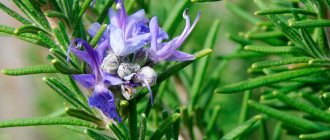The bacopa plant, which originated in distant Africa, has long become a favorite addition to many balconies; it is also often planted in hanging flowerpots in country houses, and photos of bacopa flowers are widely presented on various gardening forums.
Brief overview of the article
- Bacopa seedlings
- Bacopa and planting in the ground
- Boarding rules
- Bacopa care
- How does bacopa overwinter?
- Features of Bacopa
- Pests of bacopa and its diseases
- Topping
- How to water bacopa correctly
- Why does bacopa need to be replanted?
- Useful characteristics of bacopa
- Types of Bacopa
- Photo of bacopa
Bacopa seedlings
Planting this plant in open ground is possible only in its fully formed form. In some warm regions, the flower is planted for seedlings as early as mid-February.
The deadline for sowing is the end of March. It takes approximately 1.5 to 2.5 months for the seeds to germinate. Seedlings are the main way for the bacopa plant to emerge. Growing from seeds is usually carried out in peat pots.
Growing process
Bacopa is an ampelous plant that can be planted in a personal plot. Growing bacopa from seeds is not difficult. Sowing of the material is carried out at the end of March, when the soil has warmed up a little.
It is recommended to calcinate the earth mixture at a temperature of 100 degrees. This will destroy all pathogenic microorganisms in the soil.
After this, the finished mixture is cooled. Upon completion of the preparation of the substrate, surface sowing of seeds is carried out.
For quick germination, cover the pot with plastic wrap. As a result, a greenhouse microclimate is created, which has a beneficial effect on the growth process of the crop.
After the planting material is formed, it is planted in a shaded and windless place. The absence of intense solar radiation ensures lush flowering of the plant.
As for the soil mixture, the breed does not require any special earthen compositions. For the normal functioning of bacopa, experienced gardeners recommend observing an interval when planting. It is about 35 cm between each bush.
Bacopa and planting in the ground
Since the plant is heat-loving, it must be planted after all sub-zero temperatures have passed. As a rule, the second half of May is a suitable period.
Before planting greenhouse seedlings directly into the ground, they need to be prepared, for example, they can be taken out of the room onto the balcony so that the plants get used to a lower temperature threshold. Moreover, one day will not be enough; it is advisable to carry out such preparation for at least a week.
It is worth protecting bacopa from direct daytime sunlight so that aggressive lighting does not burn the flowers. But the calmer morning and evening sun will, on the contrary, have a beneficial effect on them.
Breeding in hanging baskets
This bush looks very advantageous in decorative boxes on balconies, in hanging baskets that are hung on garden decorations, poles and fences. Thin branches with graceful foliage and delicate flowers are good both on their own and go well when planted together with geraniums, fragrant tobacco and other garden annuals.
Photos of bacopa can often be found in European themed magazines on ornamental gardening and garden design.
Boarding rules
In addition to the sun's rays, the basic rules include sheltering flowers from winds, which not only adversely affect the plant, but can also disturb it so much that the flower dies.
As a rule, planting bacopa should be no closer than twenty centimeters from each other. But there are more compact varieties, then a distance of ten centimeters will do.
Description
The genus Bacopa includes more than 60 species that are classified as succulents. This means they are hardy because they store nutrients in their tissues. Another name for this flower is sutera. South America is considered its homeland, but thanks to its unpretentiousness and high vital potential, the plant was able to spread across all continents except Antarctica. This was due to its fast growth, adaptability to different climates and excellent root formation. If the root manages to catch on in a suitable place in a crevice or on the branches, cascading shoots up to 60 cm in length quickly appear. But this crop cannot winter in the cold, so in the middle zone it is grown as an annual.
The creeping plant quickly fills all open areas, and debris from winds can take root in new terrain. The long flowering of sutera, which lasts in waves throughout the season, is valued. The color of the flowers varies from white to purple; the inflorescences are formed in the axils of the leaves. The leaf blades of bacopa are bright, juicy, they look very decorative, so even a non-flowering bush decorates the landscape. It is most often used to create a design in the Provence style, since the plant bears a large number of bright inflorescences all summer.
Bacopa care
For the bacopa plant, care and cultivation are not easy tasks, so not everyone gets the desired result. After the plants are planted, they must be periodically carefully loosened, watered and weeded as the need arises.
The bacopa plant needs to be corrected for the presence of dry leaves and flowers, which are removed as they bloom.
Trimming and picking
An unpruned sutera with a small number of branches does not look very attractive. Therefore, in order to achieve good bushiness and form a beautiful crown, you should start pruning immediately after rooting. Then pinching is carried out as the bush grows. Pruning is performed at the growth points of branches.
It is also necessary to pinch bacopa if the sprouts begin to elongate greatly.
On a note! For the bush to have an attractive appearance, the length of the shoot should not exceed 65 cm.
Before transplanting the sutera to a permanent place, it is necessary to make a pick. The first procedure is carried out after the seedlings have rooted and the third leaf appears. Young shoots are transplanted into common boxes and pots at a distance of at least 2 cm.
Features of Bacopa
It is interesting that even with heavy rains, the shape of its flowers will not be damaged in any way, although the plant itself is fragile and requires a special approach in everything, starting with planting seeds.
Often photos of bacopa flowers can be seen precisely after rain, since the perception is created as if the plant had even more revealed the secrets of its extraordinary beauty.
Pests of bacopa and its diseases
If there is no good ventilation, fungi may begin to attack the plant. If flowers are planted in the shade, they may not only begin to get sick, but also produce very modest buds. In winter, you should not keep flowers in heavily insulated rooms, as the foliage will be damaged.
In the presence of scorching sunlight, the plant will begin to turn yellow. Dangerous pests for bacopa are whiteflies, aphids, and spider mites, so it is important to inspect the plants and, if necessary, use remedies for these pests, the choice of which is now sufficient.
Varieties
Breeders paid attention to bacopa only in the late 90s of the last century, but during this short time many new varieties and hybrids with various colors and larger flowers appeared. Each species, subspecies and breeding group has its own characteristics and strengths that must be taken into account when choosing a variety.
Experts recommend paying attention to the following types of bacopa:
- Caroline (Bacopa caroliniana). Changes the color of leaf plates depending on the illumination of the area. In the shade they are dark red, and in the sun they are light green. Requires high humidity and is often cultivated as a plant for a bottle garden. It is possible to grow on the shore of a pond or artificial reservoir. Sometimes it is located right on the coastline.
- Australian (Bacopa australis). Low-growing species, can grow directly in water. On the upper part protruding above the water, small blue flowers open.
- Monnieri (Bacopa monnieri). This succulent resembles a crassula (money tree) in miniature, but with cascading shoots. The leaves are so dense that the plant looks like a bright green mat or ball.
- Heart-shaped (Bacopa cordata) . Low-growing form, height - no more than 15 cm. Depending on the variety, the foliage can be medium in size or very small. Leaf blades with uneven cut edges.
- Spreading (Bacopa diffuses). Many varieties are capable of changing color during flowering: immediately after opening they are brighter, but fade over time. Since new buds form throughout the summer, petals of different colors can be seen on the bush, which makes it colorful and unusual. A nice feature is that even after rainy weather the plant does not become less attractive.
- Blutopia (Bacopa Blutopia F1). A wonderful hybrid for hanging cultivation, it blooms in powerful waves. Requires plenty of sun and fertilizing to reach its full potential.
- Snowtopia F1 white (White). Ideal for growing in hanging pots. The shoots hang down to 15 cm, but can grow up to 60 cm in width, which allows the hybrid to be used as a ground cover crop.
- Terry Ampel Snowball (Double Snowball). Double flowers are white with two rows of petals. Because of this, the crown looks very dense.
The most popular is the ampelous sutera; aquatic forms are grown mainly by landscape design specialists.
How to water bacopa correctly
A flower that has gained strength can cope with interruptions in watering, while simply reducing its flowering. But for young plants, the lack of watering is detrimental, so you should approach these flowers carefully and do not forget to provide them with the necessary amount of water.
If bacopa grows on the balcony, then it is advisable to water it with water that has stood for a certain time; you can also use a filter. At home, spraying flowers is also a good idea.
Reproduction
In addition to the seed propagation method, there is another one - the process of cuttings. To do this, it is necessary to use small remnants of shoots, the length of which is about 15 cm.
Garden hibiscus - types, description, planting, care and propagation + 69 photos- Celosia - growing from seeds and seedlings, planting in the ground and care rules + 80 photos
Clematis - general information, cultivation, planting conditions, care and reproduction + 88 photos
After this, they are placed on a moistened area of soil for dense rooting. Axillary roots quickly grow to the ground, thereby ensuring good fixation of bacopa.
After some time, you can observe a dense cover of this plant. The optimal period of time for harvesting cuttings is considered to be the beginning of January or the end of March.
Why does bacopa need to be replanted?
The ampelous Bacopa plant requires mandatory replanting, which must be done once a year. This action must be carried out before the first buds appear, otherwise it will radically damage their formation.
Before changing the place where the flower will continue to grow, you must carefully examine the roots; if there are rotten or painful ones, they must be removed so that the entire root system is not infected. Don’t forget about drainage and watering as much as possible.
Useful characteristics of bacopa
Many herbalists note many beneficial properties of the plant, due to the fact that it contains antioxidants. For example, if you start eating leaves, you can improve not only memory, but also brain activity in general.
Moreover, bacopa is also a kind of elixir of youth, that is, the plant slows down the processes of organisms responsible for its aging.
Medicinal properties of the plant
Bacopa is also known as a medicinal plant. The substances contained in it have antiseptic, healing, anti-inflammatory, tonic, sedative, diuretic and astringent properties. Suteru is known to be used for:
- collagen production and slowing down the aging process of the skin;
- strengthening the walls of the stomach and normalizing acidity;
- neutralization of alcohol;
- lowering cholesterol levels;
- getting rid of bacteria that carry genitourinary diseases;
- positive effect on the nervous system;
- stimulation of blood circulation in the brain.
Bacopa is most effective when combined with other medicinal plants. But when taking such drugs, a side effect was noted - men experienced a decrease in sperm activity, which negatively affected reproductive function.
Bacopa will decorate any flower bed, winter garden or home greenhouse. The main thing is to choose the right variety and provide the plant with proper care.
marked
Your opinion is very important to us. Please rate the article: rated 5 , rating: 3.20 out of 5
See also related articles
Eschynanthus: home care, photo
Scindapsus: home care
Campanula: home care after purchase and transplantation
Philodendron: home care, photos, types
Peperomia obtufolia: home care, photo
Fatshedera: care at home
Dichondra “Emerald Falls”: growing from seeds at home
Hedera "Helix mix": home care
Stephanotis: home care, reproduction
Ceropegia Wood: care at home
Cissus: care and reproduction at home
Pilea: home care
Add a comment Cancel reply
You must be logged in to post a comment.
✿ Alphabetical index
✿ Categories
- Houseplants
- Bromeliads
- Decorative foliage
- Trees and shrubs
- Orchids
- Succulents
- Blooming
- Perennial
✿ Popular articles
- How to grow chestnut from a nut at home in a pot
- Clematis: care and cultivation in the garden
- How to grow lemon from a seed at home with fruits: step by step
- Campanula: home care after purchase and transplantation
- How to grow pomegranate from seeds at home to produce fruits
- Decembrist flower: care at home, how to water correctly
✿ Latest comments
- Lyudmila on How to grow a lemon from a seed at home with fruits: step by step
- Tatyana on Tillandsia Anita: care at home
- LOVE for the entry Tulips: care and cultivation in the garden
Copyright © 2018-2021 GARDENER'S BOOK.
0+ By using bookgardener.ru you accept the terms of the USER AGREEMENT. Copyright for the posted materials belongs to the editors of the online magazine. When reprinting and using materials, an active hyperlink to BookGardener.ru is required
Types of Bacopa
- Carolina - can be classified as one of the highest flowers, analyzing all categories. In some cases, such a plant can reach a meter in height.
- small-leaved - used in the production of drugs related to brain function
- heart-leaved - height no more than twenty centimeters. Blooms in delicate shades
- spreading - a ball forms during flowering
- Madagascar - a remarkable feature is that half of this plant can grow from water
- woolly - often used for various aquariums
- pinnate - has the ability to grow rapidly and is also widely used in aquariums
Perhaps only a gardener who does not have the relevant experience can fail to appreciate bacopa. This plant is very popular in Europe. There you can often find it in the form of home decoration or even interior decoration.
These flowers are able to attach to different surfaces; the main thing is to choose the right variety for the tasks that bacopa will have to implement, without forgetting its useful characteristics.
general information
Bacopa is also called sutera, and is a herbaceous plant with straight or, more often, creeping stems. Some perennial varieties become woody over time. Bacopa shoots are densely covered with small bright leaves, the juice of which smells like citrus. The entire green part may have slight pubescence.
The Bacopa genus is very diverse. It contains true succulents that can easily tolerate drought and store water in their fleshy leaves. And there are moisture-loving species that can grow in water and are even used for landscaping ponds or aquariums.
Photo: yage.ru











